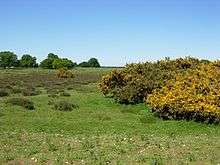Thetford Heaths
Thetford Heaths is a 270.6 hectare biological and geological Site of Special Scientific Interest in Suffolk.[1][2] It is a Nature Conservation Review site, Grade I,[3] and parts of it are a National nature reserve,[4][5] and a Geological Conservation Review,[6] It is part of the Breckland Special Area of Conservation,[7][8] and Special Protection Area[9][10] A large part of this dry heathland site is calcareous grassland, and some areas are grazed by sheep or rabbits. There are several nationally rare plants and an uncommon heathland bird, and many lichens and mosses.[11]
| Site of Special Scientific Interest | |
 | |
| Area of Search | Suffolk |
|---|---|
| Grid reference | TL 851 801[1] |
| Interest | Biological Geological |
| Area | 270.6 hectares[1] |
| Notification | 1993[1] |
| Location map | Magic Map |
The site
Thetford Heaths is an area of dry heathland in the Breckland. A range of soil types gives rise to areas of a variety of grassland types including calcareous, neutral and acidic, as well as scrubland and regenerating deciduous woodland. Part of the site is owned by the Norfolk Naturalists Trust and is managed as the Thetford Heath National Nature Reserve, and part is used for training purposes by the army. The calcareous grassland is grazed in places by sheep and is dominated by sheep’s fescue, crested hair-grass and meadow oat-grass. In the shortest, rabbit-nibbled turf, there may be little grass, and small herbs such as purple milkvetch, early forget-me-not and little mouse-ear may predominate, along with lichens.[11] Longer grassy areas have such plants as bird's-foot trefoil, lesser meadow-rue, lady’s bedstraw and small scabious. Where they can get a foothold, annual species such as common whitlowgrass, thyme-leaved sandwort and shepherd’s cress occur. Other areas of heathland are dominated by heather, and lichens and mosses.[11]
Birds of importance in the Breckland include the Eurasian stone-curlew, the European nightjar and the woodlark.[10]
References
- "Designated Sites View: Thetford Heaths". Sites of Special Scientific Interest. Natural England. Retrieved 13 June 2017.
- "Map of Thetford Heaths". Sites of Special Scientific Interest. Natural England. Retrieved 13 June 2017.
- Ratcliffe, Derek, ed. (1977). A Nature Conservation Review. 2. Cambridge, UK: Cambridge University Press. p. 136. ISBN 0521 21403 3.
- "Suffolk's National Nature Reserves". Natural England. Retrieved 3 May 2017.
- "Designated Sites View: Thetford Heath". National Nature Reserves. Natural England. Retrieved 5 May 2017.
- "Thetford Heath (Quaternary of East Anglia)". Geological Conservation Review. Joint Nature Conservation Committee. Retrieved 3 May 2017.
- "Breckland". Special Areas of Conservation. Joint Nature Conservation Committee. Retrieved 4 May 2017.
- "Designated Sites View: Breckland". Special Area of Conservation. Natural England. Retrieved 10 May 2017.
- "Designated Sites View: Breckland". Special Protection Area. Natural England. Retrieved 10 May 2017.
- "Special Protection Areas under the EC Birds Directive. Breckland" (PDF). Joint Nature Conservation Committee. Retrieved 4 May 2017.
- "Thetford Heaths citation" (PDF). Sites of Special Scientific Interest. Natural England. Retrieved 22 March 2020.
| Wikimedia Commons has media related to Thetford Heaths. |